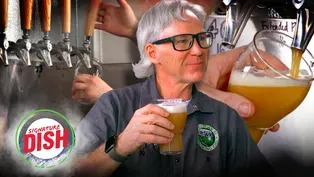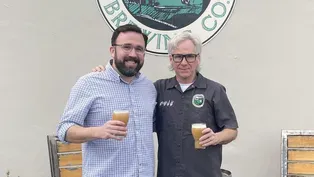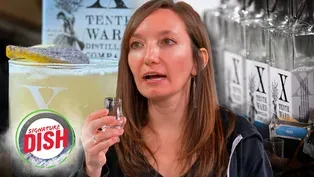Signature Dish
Explore Ancient and Modern Winemaking Techniques with BARREL OAK WINERY
Clip: Season 3 Episode 7 | 8m 54sVideo has Closed Captions
Seth heads to Barrel Oak Winery in Delaplane, VA where he samples a glass of aged Norton wine.
Seth Tillman visits BARREL OAK WINERY in Delaplane, Virginia to explore the art of winemaking from vine to bottle. Guided by vintner Jeremy Ligon, Seth helps stomp Chambourcin grapes, samples Norton grapes straight from the vine, and learns how their high malic acid and thick pulp contribute to bold, complex wines. The tour highlights modern techniques including fermentation with selected yeasts.
Problems with Closed Captions? Closed Captioning Feedback
Problems with Closed Captions? Closed Captioning Feedback
Signature Dish is a local public television program presented by WETA
Signature Dish
Explore Ancient and Modern Winemaking Techniques with BARREL OAK WINERY
Clip: Season 3 Episode 7 | 8m 54sVideo has Closed Captions
Seth Tillman visits BARREL OAK WINERY in Delaplane, Virginia to explore the art of winemaking from vine to bottle. Guided by vintner Jeremy Ligon, Seth helps stomp Chambourcin grapes, samples Norton grapes straight from the vine, and learns how their high malic acid and thick pulp contribute to bold, complex wines. The tour highlights modern techniques including fermentation with selected yeasts.
Problems with Closed Captions? Closed Captioning Feedback
How to Watch Signature Dish
Signature Dish is available to stream on pbs.org and the free PBS App, available on iPhone, Apple TV, Android TV, Android smartphones, Amazon Fire TV, Amazon Fire Tablet, Roku, Samsung Smart TV, and Vizio.
Providing Support for PBS.org
Learn Moreabout PBS online sponsorshipSETH: What a beautiful spot.
Grapes on the vine, and I see a whole bunch in the barrel here.
JEREMY: Well, yeah, that's why you came because we need some help making wine today.
So, we're going to stomp these grapes and bring it all the way back to the beginning of winemaking.
SETH: Well, I've gotten my hands dirty on the show before, but getting my feet dirty, that's a new one for me.
JEREMY: Well, hey, that's good.
There's a first for everything, right?
SETH: All right.
Well, I'm sorry that the viewers at home have to see my feet.
JEREMY: You got to do what you got to do to make great wine.
You can't really go wrong.
You can feel it's very squishy.
You can see this is actually Chambourcin grapes.
It's a big, fat, juicy grape.
SETH: It's me and the bees in this barrel today, so they're making me a little bit nervous.
JEREMY: Don't worry, they're much more interested in those grapes and grape juice than you.
SETH: And was there actually a reason that people would stomp on grapes?
JEREMY: Yeah, this way of crushing grapes is actually a really gentle way to press the juice out.
You're not cracking any seeds and getting bitter flavors, but you're using you are feet.
But after two or 300 people or have their feet in here, it's not something that I really want to produce good wine out of.
SETH: Well, I'm glad the technology has come a long way over the centuries.
JEREMY: Me, too.
SETH: All right, why don't you show me how you actually make wine?
JEREMY: Yeah, come on.
Let me show you how we do it.
So, amazing wine starts in the vineyard.
We grow nine varieties here at Barrel Oak.
Let me take you to a piece of Virginia's history and jump in the golf cart.
SETH: Oh man, I'm on board.
JEREMY: This thing is electric, so it's really quiet but it's really nice.
SETH: As Jeremy takes me on a ride through Barrel Oak's 78 acres, our destination is the plot of Norton Grapes.
The grape once grew wild in these fields, but it was first cultivated by its namesake, Dr. Daniel Norton, in the early 19th century.
After a long period of neglect for the homegrown species, the Norton grape is once again a cornerstone of the Virginia wine industry.
So, this is the fun part of the job getting to come out here to the fields.
JEREMY: Exactly.
It's pretty cool because it's actually where we believe Dr. Norton lived at one point.
So, we actually grow Norton right here in front of this house.
SETH: Oh, I love that.
JEREMY: Now let me tell you a little bit about how we grow our Norton vines.
These we actually do on a high wire, so that the vines are actually growing down.
They're the wild vine, you know, that's what we call it.
SETH: And, uh, you wouldn't mind if I try one of these grapes just right off the vine?
JEREMY: No, please.
Come on, let's have some.
Norton's actually known for having a lot of malic acid, so you'll get that nice acidity and then you'll get some of that sweetness up front.
SETH: And a crunch.
JEREMY: And a crunch.
That's right.
So, all these have seeds in it, what I like to do, is actually examine the seed and what I'm looking for is ripeness in the seed as well, because that gives me a good indication of ripeness of the grape.
You can see there's actually not much green at all.
Then I'll eat the seed itself and then I'm looking for a consistency of almost a sunflower seed.
You can tell that it's just about ripe.
SETH: You've got a tough job, man.
You got to come out here and snack on grapes.
JEREMY: Somebody's got to do it.
SETH: It's science.
It's science, right?
JEREMY: What's really different about these is they're so pulpy.
Actually, peel the skin off.
This is one of the only grapes with a complete pulp that will stay intact and it's just very thick.
It's got all these nice, beautiful, concentrated flavors in it.
You don't get quite as much juice per ton because it is so pulpy, but the juice that you get is intense with impacted flavor.
SETH: All right, so the juice is worth the squeeze on this one?
JEREMY: Every time.
Absolutely.
SETH: And so, how many more days before you're ready to pull these things in and start making some wine?
JEREMY: We're actually going to be harvesting soon, probably next week.
SETH: All right, so this is basically peak freshness right here that we're the tasting.
JEREMY: Yeah.
Let's go back to the cellar and I've got some aging in barrels right now.
SETH: Let's do it.
On our way to the cellars, Jeremy first shows me a few tools of the trade while another grape variety is processed.
These massive machines include the de-stemmer, which removes all stems, leaves, and debris from the grape, and the press, which gently extracts the juice, no feet required.
From there, the fermentation process with the yeast begins.
JEREMY: So, the juice that we're extracting right now, we're actually pumping it into our tanks, but most of our red wine we ferment in these one-ton bin fermenters.
You can see here we've actually got some beautiful Cabernet Franc.
Some of our wines get different yeasts to bring out different types of flavors.
We also do some native fermentation here as well, where we'll let the grapes naturally ferment with some of their own yeast.
So, it's pretty simple... SETH: To give the yeast a much-needed breath of fresh air, Jeremy and his team give the grapes two punchdowns a day, which I was only too happy to try my hand at.
Oh, boy.
All this oxygen is going to help yeast come to life a little bit?
JEREMY: Yeah.
As you're doing this, we're giving the yeast a chance to breathe, release it's C02 and make it happy.
You know, we want to have very healthy yeast and a happy yeast, because it's going to produce the best wine possible.
SETH: Well, there's the science part of it and then there's the farm work part of it.
JEREMY: Yeah, that's right.
SETH: This is the farm work.
After fermenting for a few weeks, the juice for the reds is pressed out and then put in oak barrels to age, which is the final stop on the tour.
JEREMY: This is our cellar, this is our main barrel room.
SETH: While the Nortons will age for a little over two years, Jeremy is using his wine thief so we can sample one that's been sitting for just under a year.
JEREMY: If you just hold your glass out.
What we want to do when we taste it is we want to swirl it.
We want to take a look at the color and then you want to give it a nice smell.
SETH: Of course, a little sniff.
Mmm.
Well, I think that's pretty good, but I'm guessing from a vintner's perspective there's a little more work that needs to be done.
JEREMY: Absolutely.
Yeah, this has got a little ways to go.
It is tasting nice today, but with Norton being such high in acid, we want it to sit in this barrel for at least another year round that acid out and be it nice and smooth.
We've got a beautiful 2021 Estate Norton, and, you know, it'd be fun to show you something that's a finished product.
SETH: Oh, that sounds good.
All right, Jeremy, Kavelle and Ken, this is the moment that I've been waiting for.
How are we doing this?
JEREMY: So, we're going to start off with our Estate Norton, which is 100% Norton.
So, just over two years in barrel.
Then since it's been in the bottle, it's been just over almost a year, you'll see Norton's got that dark, inky really heavy color and then you want to give it a smell.
SETH: And, of course, before we sip, cheers to a wonderful day at the winery.
KEN: Cheers.
I like this one.
Really good.
JEREMY: So, you get a lot of that blackberry, that black currant on the nose.
You get that prevalent acidity that you'll get from Norton, but then it's actually the mouthfeel is just starting to round out, so that crisp finish.
SETH: That's excellent wine.
JEREMY: It's a labor of love.
KAVELLE: Especially drinking it with a winemaker.
SETH: Of course.
And Kavelle, what do you love about this particular wine?
KAVELLE: It's not so difficult to drink.
It's an easy-drinking wine.
I love the color.
Nose is good.
SETH: Are these two more different types of Norton on the table here?
JEREMY: Yes, actually this is our sparkling Norton, which is, you know, very unique.
I actually have never seen another sparkling Norton in the entire world.
During the fermentation of Norton, there's actually a period where it smells like pink bubblegum.
KAVELLE: Ooh.
JEREMY: And, so... the idea for this wine was to try to harness that smell and keep it so that in the finished product... in the finished product you actually get some nice pink bubblegum flavors.
SETH: All right, so we're entering the world of nice, light summer drinking here.
JEREMY: Yes, yes.
Light, summer, unique.
You know, we did a classic sparkling press cycle on this, which is very gentle because you don't want to extract any of those tannins and all that heavy stuff, and so kept it really light, definitely unique, different and hopefully something that you enjoy.
KEN: We have always told Jeremy, "Think outside the box.
Let's produce unique and the best wines."
SETH: Well, this is definitely unique, and speaking of unique, I'm seeing a dog and, uh... looks like a goat on the front of this one?
JEREMY: Yeah, that is a goat.
We work with different local artists to do a drawing for one of our wine labels.
This is actually a blend of Norton and Chambourcin, they grabbed you to foot stomp out here.
And, so, we bring it full circle to where you can try a nice blend of the two.
It's a great spring and summertime wine.
It's a great backyard barbecue wine.
SETH: Well, it's amazing that even with the Norton itself, three different bottles of wine, three totally different flavors, but something, I guess, for everybody.
Maryland's STREETCAR 82 BREWING CO. is a Spot for Deaf and Hearing Beer-Lovers Alike
Video has Closed Captions
Seth visits Hyattsville, MD's Streetcar 82 Brewing Co. for a pint of the Fancy Nancy hazy IPA. (7m 26s)
Watch Maryland's TENTH WARD DISTILLING COMPANY Make A Classic Genever-Style Gin
Video has Closed Captions
Seth visits Tenth Ward Distilling Company in Frederick, MD to sample the Queen Bee's Knees cocktail. (5m 12s)
Providing Support for PBS.org
Learn Moreabout PBS online sponsorshipSupport for PBS provided by:
Signature Dish is a local public television program presented by WETA














